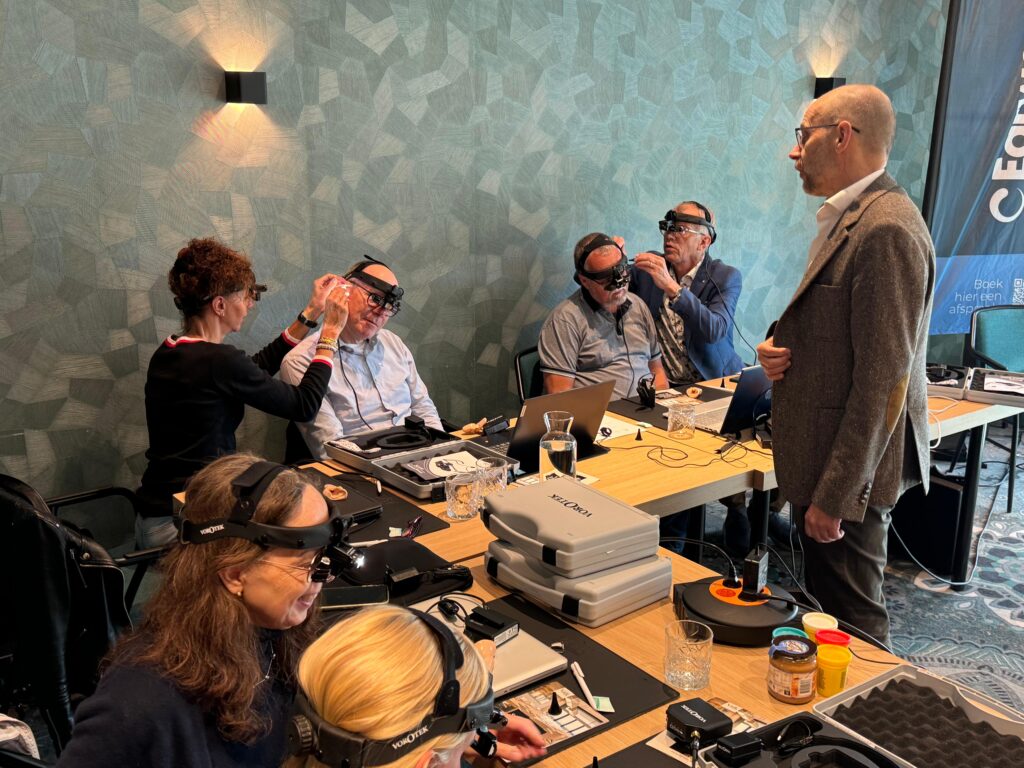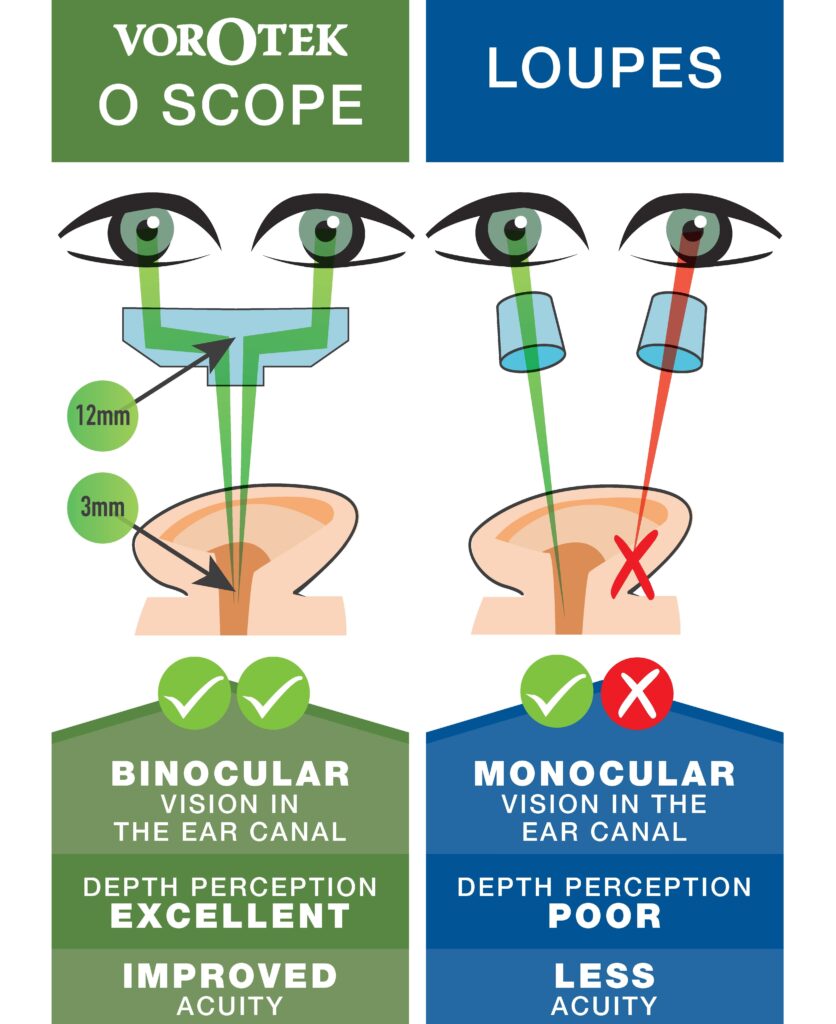The Benefits of Dry Ear Cleaning vs Ear Syringing
In this comprehensive scientific article, ENT physician Jan Rombout, Registered Nurse Meg Bumpstead and ENT physician Jurgen P. te Rijdt, MD compare the two methods of cleaning ears.
Enter your email address below to download the article in PDF.
Summary
Dry Ear Canal Cleaning (DGR) using instrumental removal techniques (with the microsuction pump and/or curettage) under direct binocular vision have proven to be faster, safer, more effective and more appropriate for a wider range of patients. Currently, dry ear canal cleaning is the ENT physicians’ gold standard for earwax removal.
Many health professionals still use the old-fashioned method of earwax removal: irrigation or blowing out. This article aims to raise awareness regarding recent developments that make DGR more accessible.
Recent innovations in micro-suction equipment and forehead-worn microscopes allow a cost-effective transition for entrepreneurs on a tight budget. Quality training combines e-learning and hands-on learning to minimize training time.
These developments allow organizations involved in syringe removal to begin manual removal to reduce risk, improve patient comfort and help a wider range of patients more effectively.
Triage audiologists not yet active in ear wax removal can also begin using DGR to provide more care and better quality.

Direct binocular vision combined with microsuction increases effectiveness
Ear spraying or irrigation is no longer a recommended or supported technique for earwax removal, according to the 2017 US Clinical Practice Guideline Earwax (Cerumen Impaction) and the 2023 UK NICE Clinical Knowledge Summary.
Spraying out sometimes leaves earwax behind, requiring the client to return for secondary or tertiary treatment.
Without direct vision, it is unclear to the professional what the effect of the irrigation is. During DGR with microsuction, the professional always has direct vision of the ear canal with both eyes. This allows all earwax to be removed, this ensures effective treatment, saving both patient and professional repeat visits.
Spraying out does not remove impacted (plugged) earwax. By combining microsuction with curettage, DGR is effective in most cases and provides a more certain, better result.
In one study, the success rate of cerumen impaction removal with syringe was only 70%. Success rates for DGR with a forehead-borne microscope were significantly higher at 90%.
Inserting pressurized water into the ear is an unnecessary risk factor
In several studies, blowing out the ear canal with tap water is a risk factor that can lead to ear infections and eardrum perforation in certain patient types.
The main reason for complications is the buildup of water pressure when the syringe blocks the entrance: water can enter the ear canal and have difficulty escaping, leading to high pressure and possible eardrum rupture.
ENT surgeons in the Netherlands used to flush out ears with water, but this is no longer done because of the potential complications. Modern ENT treatment units do not even have a water applicator anymore.
Nevertheless, ear gouging is still common in many general practices. In practice, the treatment itself is usually outsourced to the family physician assistant(s).
About 40% of 300 general practitioners who performed irrigation for earwax removal reported medical complications. In Australia, 20% of claims for medical negligence at GP practices related to earwax removed by irrigation.
DGR without water is less likely to lead to secondary infection. It also does not exert pressure on the ear canal or eardrum, eliminating the risk of dizziness, nausea and perforation. Also, the absence of water makes it less messy and a more pleasant experience.
DGR under direct vision is also the only safe method for earwax removal when it cannot be assessed whether the eardrum is intact, prior to earwax removal. If pressurized water is introduced in an undiagnosed perforation, it can cause disruption of the delicate ossicles (small bones in the middle ear that are essential for hearing), which can lead to hearing loss.


Photos above: Two images of the same plugged ear wax with some yellow yeast. The first picture was taken before and the second after the ear was spat out; The physician’s assistant was convinced that the ear canal was clean and reported a normal eardrum after the procedure. However, the blowing out loosened some skin sheets, which were misinterpreted as the eardrum because of its grayish glistening aspect. The water also spread the yeast through the ear canal and is also present on the skin of the ear canal in the second photo.
DGR is faster and saves time for everyone
Earwax removal by microsuction under direct vision of a head-worn 3D microscope, is a short procedure of 5 to 10 minutes. In addition, the direct 3D view allows for better recognition and early detection of pathology, which can be adequately addressed or referred to a primary care or ENT physician.
Combined with the higher effectiveness, this leads to a very positive outcome for both patient and practitioner.


The pictures above are two video images of the same ear, one on the left side with earwax pressed on and one on the right side after cleaning with microsuction.
By offering DGR, more patients can be treated
Direct 3D vision is essential for the safe removal of earwax.
There are several situations in which irrigation can lead to serious complications, and manual removal of earwax is strongly recommended in these cases:
- A history of previous problem with irrigation (pain, perforation, dizziness);
- Current or prior history with perforation of the eardrum;
- Tubes are present;
- An ear surgery in history (excluding tubes, more than 18 months ago, with subsequent discharge from an ENT department);
- Mucous discharge from the ear (which may indicate an undiagnosed perforation) within the past 12 months;
- History of middle ear infection in the past six weeks;
- Acute Otitis Externa with an edematous ear canal and painful auricle;
- Presence of a foreign body, including plant material, in the ear; hygroscopic material, such as peas or lentils, will expand on contact with water, making removal more difficult;
- Cleft palate, whether repaired or not;
- If the ear to be treated is the only hearing ear, because there is a small chance that irrigation can cause permanent deafness;
- Agitation because the patient may not be able to sit still;
- Patients with difficulty speaking, for example, young children and some people with dementia or learning disabilities.

Invest to reduce risk of pain and save everyone time
Safe and effective ear wax removal depends on health care providers using optical equipment to accurately assess small distances in the ear canal. This is known as “Depth Perception.”
Use of the forehead-borne binocular microscope provides excellent depth perception (3D vision) through the unique converged optical paths, allowing both eyes to see the ear canal and eardrum.
It is a common misconception that traditional magnifying glasses or video otoscopes give good depth perception.
These devices have monocular optical paths that do not provide good depth perception in the ear canal, making it impossible to estimate small distances accurately and less safe to work with.

In the illustration:
The Vorotek O Scope is a unique forehead-worn microscope often used in Australia by ENT doctors alongside – or as a mobile alternative to – their larger fixed (surgical) microscope.
The Vorotek O Scope virtually reduces pupillary distance (IPD) so that one looks through a narrow canal such as an ear canal or nose with both eyes, rather than with one eye, to improve depth perception and thus increase patient safety.
In addition to using proper optical equipment, microsuction and curettage DGR requires investment in high-quality suction equipment and instrumentation, and it is important that a well-trained experienced professional perform the procedure.
Training that does not interrupt business operations
Education and protocols cover the complete anatomy of the ear, knowledge of ear disorders and pathophysiology, precautions to be taken, practice, documentation and recording of treatment, education to – and consent of – the client, and dealing with potential awkward situations and poor outcomes.
High-quality, cost-effective and time-saving training DGR is now available as a combination of e-learning, practical hands-on training and remote ENT supervision, minimizing business interruption.
The benefits of investing t.b.v. DGR to replace irrigation are a lower risk profile, more effective and rapid removal of earwax in a wider range of patients, better and more accurate pathology recognition and a more pleasant patient experience.
All this leads to higher quality ear care and reduced pressure on primary and secondary care.
References
Seth R. Schwartz, MD, MPH, Anthony E. Magit, MD, MPH, Richard M. Rosenfeld, MD, MPH. The American Association of Otolaryngology, Head and Neck Surgery Foundation -. Clinical Practice Guideline (Update): Earwax (Cerumen Impaction)., 2017, Vol. 156(1S) S1-S29
NICE – National Institute for Health and Care Excellence. Hearing Loss in Adults: Assessment and management; Nice Guidelines NG98 Methods, Evidence and Recommendations., June 2018 (updated October 2023)
Disclaimer
ENT physician Dr. Jan Rombout is the owner/founder of OnlineKNO Physician, which offers ENT services outside the hospital. To ease the burden on the healthcare system, he also offers best-practice training for DGR and ENT supervision to audiologists, audiologists and physician assistants through a partnership with Alsoka Medical in the Netherlands.
RN Meg Bumpstead was previously co-founder and co-owner of eight highly successful ear surgery clinics in Australia, which she ran from available ENT treatment rooms. She is the founder and owner of the ClearEars Institute, which provides a top-quality e-learning environment for DGR through Alsoka Medical and others in Europe.
Alsoka Medical supplies Vorotek forehead-borne 3D microscopes and microsuction pumps and facilitates training, ENT supervision and lead generation for hearing care professionals who remove ear wax using the dry method through the EarwaxShop.